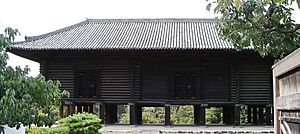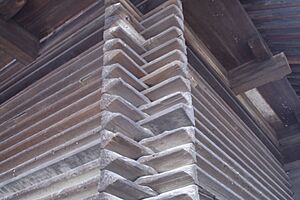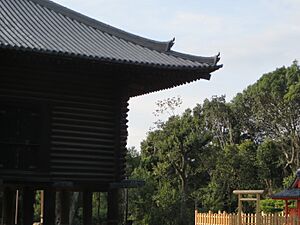Shōsōin facts for kids
The Shōsō-in (pronounced Sho-so-in) is a famous treasure house located at the Tōdai-ji Temple in Nara, Japan. It's built in a special "log-cabin" style called azekura, with its floor raised high off the ground. This unique building holds many important items that belonged to Emperor Shōmu (who lived from 701 to 756) and Empress Kōmyō (701–760). It also contains beautiful art and crafts from the Tenpyō period of Japanese history.
Contents
History of the Shōsō-in Treasure House
The Tōdai-ji Buddhist temple complex was ordered to be built by Emperor Shōmu. He started a big national project to build Buddhist temples across Japan. During his reign, known as the Tenpyō period, Japan faced many challenges. There were natural disasters, political problems, and widespread illnesses.
Because of these difficulties, Emperor Shōmu believed that building temples would help bring peace and stability. The Tōdai-ji was chosen as the main temple for all the others. Emperor Shōmu was a strong supporter of Buddhism. He also thought it would help make his government stronger.
The Shōsō-in itself began in 756. This was when Empress Kōmyō gave over 600 items to the Great Buddha at Tōdai-ji. She did this to show her love for her husband, Emperor Shōmu, who had passed away 49 days earlier. She made these donations five times over several years. The items were then stored safely in the Shōsō-in.
Later, during the Heian period, many more treasures were moved into the Shōsō-in. These included items used in important Buddhist ceremonies. After the Meiji Restoration, the building became managed by the Japanese government. Since World War II, it has been looked after by the Imperial Household Agency. The Shōsō-in is recognized as a UNESCO World Heritage Site. It is also a National Treasure of Japan.
How the Shōsō-in Building Was Made
The Shōsō-in is built in a special style called Azekura Zukuri. This is a type of log-cabin construction. The floor is raised high, about 2.5 meters (8 feet) off the ground. This building style was often used for storing grain and other important goods.
A unique feature of this style is the triangular wooden beams that fit together at the corners. What's even more amazing is that the building was put together without using any bolts or nails! This might seem surprising for a building that is about 14 meters (46 feet) tall, 33 meters (108 feet) wide, and 9.3 meters (30 feet) deep.
However, building it this way was very smart. Without bolts or nails, the structure became flexible. This allowed it to withstand earthquakes, which Japan experienced often, even back in the Nara period. The Shōsō-in is also the only building from the Siege of Nara in the Heian period that survived. We don't know the exact date it was built. But construction likely started soon after Empress Kōmyō's donations in 756 AD. It was definitely finished before 759 AD, when all the lists of stored items were complete.
Keeping the Treasures Safe
The Shōsō-in was designed to protect its valuable contents. It has a natural system to control the climate inside. The floor is raised 2.7 meters (9 feet) high. This allows air to flow underneath the building. This air circulation helps protect the structure from humidity.
Also, for many years after it was built, the triangular beams made of Japanese cypress wood helped control the humidity and temperature naturally. The treasures themselves were stored in chests made from cedar wood. Cedar is known for being very strong and lasting a long time. These chests were about 90–110 cm (35–43 inches) long, 60–70 cm (24–28 inches) wide, and 40–50 cm (16–20 inches) high. Like the building, these chests were also raised off the ground. All these careful designs helped keep the treasures in perfect condition for centuries.
The Shōsō-in Treasures
Today, the Shōsō-in holds about 9,000 items. This number doesn't even include items that still need to be identified. The treasures given by Empress Kōmyō were stored in the Northern part of the Shōsō-in. This section has always been sealed by the imperial family. You could only enter with their special permission.
Most of the beautiful art and crafts in the Shōsō-in (about 95%) were made in Japan around the 8th century. The rest came from places like the Tang Dynasty in China, Central Asia, India, and Iran during the same time. The designs on these Japanese and East Asian treasures show influences from Iran, Greece, Rome, and Egypt. This happened because of cultural exchange along the famous Silk Road trade routes.
Even though these collections are not usually open to the public, some selected items are shown once a year. You can see them at the Nara National Museum every autumn.
The many objects and treasures stored in the Shōsō-in can be grouped into these categories:
- Buddhist objects (Butsugu)
- Clothing and accessories (Fukushoku)
- Furniture (Chōdo Hin)
- Games (Yūgi gu)
- Musical instruments (Gakki)
- Weaponry (Buji)
Important Documents
Besides the treasures, the Shōsō-in also keeps over 10,000 documents. Most of these are from an eighth-century writing office. These documents include many different types of records. There are lists of people, tax records, and even poetry.
However, most of the documents are daily records from an office that copied Buddhist scriptures. This office was active between 727 and 776. This collection is very special because it's a detailed archive from the eighth century.
These documents were first found again in the 1830s by a scholar named Hoida Tadatomo. He and others carefully separated the individual sheets. Then they put them back together into new scrolls. This changed how the documents were originally organized. Printed versions of most documents were published starting in 1901. Later studies have helped experts understand how the scrolls were originally arranged. These documents have also been put online, so people can now view them digitally.
The Silk Collection
Since 1994, the office that manages the Shōsō-in has been making exact copies of ancient Nara textiles. They don't just copy the look and color. They also make sure to use the same production and weaving styles. Each year, the silk used for these reproductions is donated by Empress Masako. She personally manages the Momijiyama Imperial Cocoonery at the Tokyo Imperial Palace.
See also
- Kura (storehouse)
- Ranjatai - a famous piece of agarwood used in incense held by the repository
- The Kamakura Museum of National Treasures designed to resemble the Shōsō-in, also holds a fine collection of Japanese art and sculpture.





